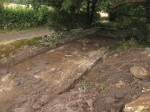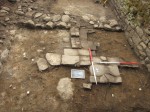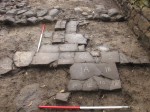 The evening of Tuesday, January 3rd, 1826, began like so many others for Joseph Hedley. He bought a pound of sugar, picked up a pitcher of fresh milk, a sheep’s head and pluck (an offal package of heart, liver, spleen, sweetbread and lungs often sold with the head) from Mrs. Colbeck, the wife of a local farmer, and headed home to his secluded cottage on the outskirts of Warden, Northumberland. At 6:00 PM, labourer William Herdman stopped by the cottage on his way back from his job at the paper mill and spent a few moments visiting with Joe. They sat by the fire and chatted while Joe prepared some potatoes for his dinner. At around 7:00 PM a peddler named Mrs. Biggs asked Joe for directions having missed her turn in the dark. That was the last time he was seen alive, except by his murderer.
The evening of Tuesday, January 3rd, 1826, began like so many others for Joseph Hedley. He bought a pound of sugar, picked up a pitcher of fresh milk, a sheep’s head and pluck (an offal package of heart, liver, spleen, sweetbread and lungs often sold with the head) from Mrs. Colbeck, the wife of a local farmer, and headed home to his secluded cottage on the outskirts of Warden, Northumberland. At 6:00 PM, labourer William Herdman stopped by the cottage on his way back from his job at the paper mill and spent a few moments visiting with Joe. They sat by the fire and chatted while Joe prepared some potatoes for his dinner. At around 7:00 PM a peddler named Mrs. Biggs asked Joe for directions having missed her turn in the dark. That was the last time he was seen alive, except by his murderer.
Four days later, some of his neighbors grew so concerned by their elderly friend’s absence that they broke into his house. They found the food he’d gotten Tuesday evening on the table as if he’d just walked in and set it down. They found Joseph lying a pool of blood in a small inner room where he kept his chickens and wood for the fire. He had been cut 44 times on his head, face, chest and neck. His hands had deep defensive wounds inflicted during the old man’s desperate struggle to fend off his attacker. A garden hoe with blood and grey hairs on the handle and head lay across his chest.
 The cottage bore the evidence of his brutal last struggle. The bed tester was torn down. Blood was found on the door lintels, the chimney, the walls, the plates on the table, and splattered on the walls and floor. His clogs were found outside, lost in a futile attempt to flee, an attempt also testified to by the muddy state of his clothes.
The cottage bore the evidence of his brutal last struggle. The bed tester was torn down. Blood was found on the door lintels, the chimney, the walls, the plates on the table, and splattered on the walls and floor. His clogs were found outside, lost in a futile attempt to flee, an attempt also testified to by the muddy state of his clothes.
The tiny cottage had been ransacked. All of the drawers and containers were open and the contents strewn about, but as far as could be ascertained, only a handful of Hedley’s few possessions — two silver table spoons, four tea spoons, two silver salt cellars — seemed to be missing. Authorities suspected the motive for the murder and destruction was theft. Despite his humble means, there was a completely unfounded rumor going around that the 75-year-old man on parish relief had secret riches stashed in the house. It seemed someone of malicious intent had heard the gossip and was willing to chop an old man to ribbons to get to the non-existent treasure.
 The brutal murder of Joseph Hedley made news around the country. A widower who had cared tenderly for his bed-ridden wife for eight years before her death, Hedley was reputedly a kind, charitable man who gave to those in need even though he himself had very little and relied on the likes of Mrs. Colbeck and the support of the parish to survive. He was more than gainfully employed, however. In fact, he was widely known as Joe the Quilter due to his gifts with the needle.
The brutal murder of Joseph Hedley made news around the country. A widower who had cared tenderly for his bed-ridden wife for eight years before her death, Hedley was reputedly a kind, charitable man who gave to those in need even though he himself had very little and relied on the likes of Mrs. Colbeck and the support of the parish to survive. He was more than gainfully employed, however. In fact, he was widely known as Joe the Quilter due to his gifts with the needle.
 Joe the Quilter started out as a tailor, but didn’t take to the trade. Pattern-cutting and seam-sewing were not for him. Decorative stitching, on the other hand, was. He became adept at stitching floral patterns, geometrics and figures onto linen and cotton. He would cut the patterns on cardboard, put the template on the fabric stretched across a frame and pencil through the holes, creating the outline of the design on the textile. Over time Joe developed an impressive collection of designs for his clients to pick from when ordering a quilt. And order they did, from Ireland and the United States as well as closer to home. Very few of his works have survived. The ones that have are in museums.
Joe the Quilter started out as a tailor, but didn’t take to the trade. Pattern-cutting and seam-sewing were not for him. Decorative stitching, on the other hand, was. He became adept at stitching floral patterns, geometrics and figures onto linen and cotton. He would cut the patterns on cardboard, put the template on the fabric stretched across a frame and pencil through the holes, creating the outline of the design on the textile. Over time Joe developed an impressive collection of designs for his clients to pick from when ordering a quilt. And order they did, from Ireland and the United States as well as closer to home. Very few of his works have survived. The ones that have are in museums.
His fame as an artisan ensured the government made a genuine effort to find the perpetrator of this heinous crime. Home Secretary Robert Peel offered His Majesty’s full pardon to any accomplices who came forward with information, as long as they were not ones who wielded the weapon. The Overseers of the Poor of Warden offered a 100 guinea reward for information leading to the capture of the culprit. A few people were arrested on suspicion of involvement in the murder, but they were released shortly thereafter. The trail went cold and the murder of Joe the Quilter was never solved.
 The cottage was demolished in 1872. By 1887, the location of the cottage was lost. Last year, student archaeologists from University College London and Newcastle University and local volunteers led by experts from the Beamish Museum began looking for the cottage. Because of the sensational murder, the cottage was recorded in architectural detail by police, journalists and others, giving researchers today rare insight into the living quarters of the working poor in Georgian England who did not, as a rule, have elevations and floor plans of their hovels drawn up for posterity.
The cottage was demolished in 1872. By 1887, the location of the cottage was lost. Last year, student archaeologists from University College London and Newcastle University and local volunteers led by experts from the Beamish Museum began looking for the cottage. Because of the sensational murder, the cottage was recorded in architectural detail by police, journalists and others, giving researchers today rare insight into the living quarters of the working poor in Georgian England who did not, as a rule, have elevations and floor plans of their hovels drawn up for posterity.
 The initial exploration in November of 2014 discovered promising clues that they might have found the cottage site. It was covered for the winter and excavation resumed last September. The dig has unearthed the bases of three walls, part of the flagstone floor, one side of the brick fireplace, evidence of a wooden partition that once separated the main room from the chicken room. About one third of the width of the cottage, including what would have been the front wall, was trimmed off when a field boundary cut through the home’s footprint. The cottage turns out to have been slightly larger than reported, about 30 feet long by 20 feet wide, or 600 square feet total surface area.
The initial exploration in November of 2014 discovered promising clues that they might have found the cottage site. It was covered for the winter and excavation resumed last September. The dig has unearthed the bases of three walls, part of the flagstone floor, one side of the brick fireplace, evidence of a wooden partition that once separated the main room from the chicken room. About one third of the width of the cottage, including what would have been the front wall, was trimmed off when a field boundary cut through the home’s footprint. The cottage turns out to have been slightly larger than reported, about 30 feet long by 20 feet wide, or 600 square feet total surface area.
The team has also found hundreds of pottery fragments, iron nails, buttons, a four-penny silver groat used for Maundy money  (charitable giving) and a bone pick, a tool used by quilters. One key artifact discovered is a copper alloy name badge inscribed “Rev R. Clarke, Walwick.” A Reverend Clarke is known to have trudged through almost impassable snow to bring succor to Joe when he was trapped by the snow and “perishing of want” during the winter of 1823. The copper plate probably came off his saddle.
(charitable giving) and a bone pick, a tool used by quilters. One key artifact discovered is a copper alloy name badge inscribed “Rev R. Clarke, Walwick.” A Reverend Clarke is known to have trudged through almost impassable snow to bring succor to Joe when he was trapped by the snow and “perishing of want” during the winter of 1823. The copper plate probably came off his saddle.
 The remains of the cottage have been numbered brick by brick, stone by stone, and will be removed to storage at the Beamish Museum. Beamish is an open air museum telling the stories of daily life in north England in the 1820s, 1900s and 1940s. A new project entitled Remaking Beamish will expand the museum to include a new typical 1950s town and to enlarge the 1820s section. Joe the Quilter’s cottage will be rebuilt, complete with the original flagstones his clogs once trod, as part of the enlarged Georgian exhibition, a poor working’s man dwelling to contrast with the Pockerley manor house of the local gentleman farmer which is in the section.
The remains of the cottage have been numbered brick by brick, stone by stone, and will be removed to storage at the Beamish Museum. Beamish is an open air museum telling the stories of daily life in north England in the 1820s, 1900s and 1940s. A new project entitled Remaking Beamish will expand the museum to include a new typical 1950s town and to enlarge the 1820s section. Joe the Quilter’s cottage will be rebuilt, complete with the original flagstones his clogs once trod, as part of the enlarged Georgian exhibition, a poor working’s man dwelling to contrast with the Pockerley manor house of the local gentleman farmer which is in the section.
For more about the discovery of the cottage and its significance, see the Beamish Buildings blog